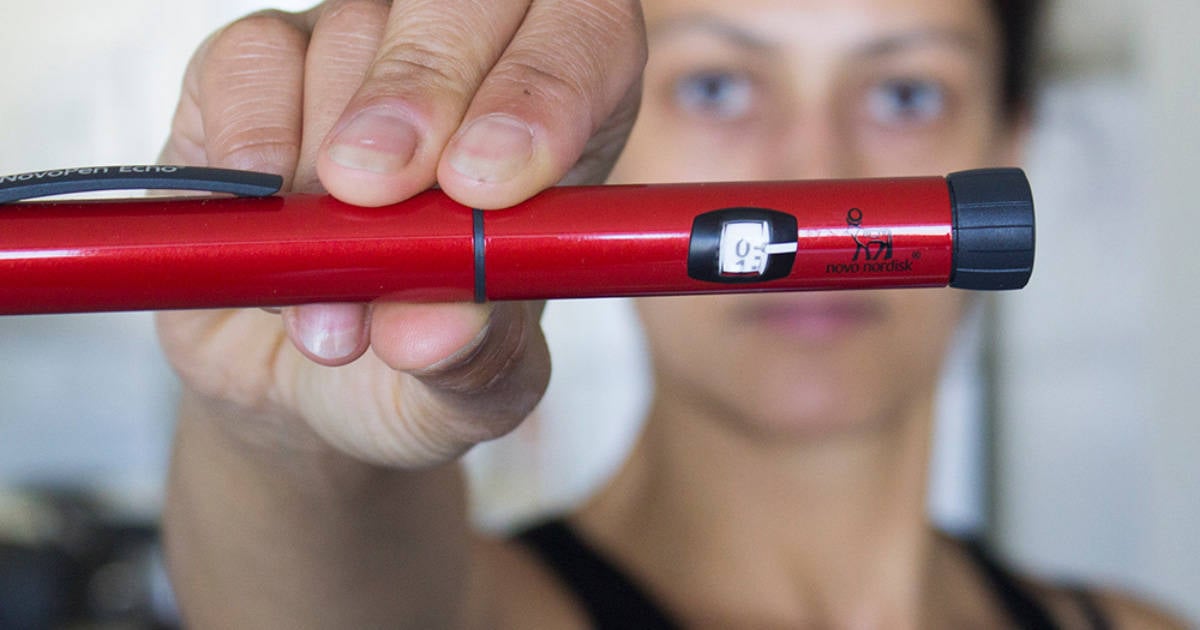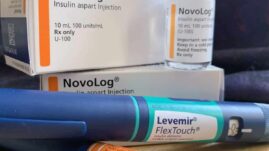Does your blood sugar seem unpredictable at times? If you live with insulin-dependent diabetes, it most likely does, and sometimes it can be hard to determine what’s going on.
That’s why it’s important to learn how to calculate your insulin on board (IOB) because if you’re not paying attention to your IOB, your blood sugars will continue to seem random and unpredictable
While paying attention to your IOB will not solve all of your daily blood sugar woes, it can help you out immensely. It’s a key component to better diabetes management and something that is not brought up often or taught enough when you are diagnosed.
Knowing your IOB can help you successfully determine things like if it’s safe to go for a walk without your blood sugar going low, or if you should inject more insulin to correct a high blood sugar, or if you should eat a snack before bed so you won’t have to wake up in the middle of the night to treat a low blood sugar.

What is Insulin On Board
Insulin on board is how much active rapid-acting insulin you have in your body. I’ve also seen it described as BOB (Bolus On Board), or unused insulin.
Rapid-acting insulin is the type of insulin people living with insulin-dependent diabetes use when we eat or need to correct highs. Common brand names of active insulin are: Humalog, Novolog, and Fiasp. It’s also the type of insulin that is used in insulin pumps.
Too much IOB will lead to low blood sugar (hypoglycemia) and too little to high blood sugars (hyperglycemia).
IOB is important since injected rapid-acting insulin can last in the body for 3-5 hours. That means that you should be paying attention not just to how many units of insulin you inject but also to how much is left of that dose up to 5 hours after your injection(s).
How long insulin is active in the body is a range (3-5 hours) because we all metabolize insulin at a slightly different rate. Most insulin pumps will be set to 3 hours, and most doctors recommend testing one’s blood sugar about 2 hours after a meal bolus, in part to check IOB and if a sufficient meal bolus was administered.
If you use an insulin pump, the pump will tell you your IOB from all boluses.
However, it’s worth noting that it does not include the basal (background insulin) which is also rapid-acting insulin. Overlooking the pump basal insulin when discussing active insulin is problematic especially for exercise, since too much IOB, from boluses or pump basal, will make blood sugars drop.
If you use insulin pens, there are a few apps available to help you calculate and keep track of your IOB such as RapidCalc (not FDA approved) or MySugr (EU only). There is also a smartpen called InPen available in the U.S.
How to calculate IOB
If you don’t have access to any devices or apps that calculate your IOB for you, or if you want to know your “pump basal IOB”, you can calculate your IOB fairly easily on your own.
In this video, I’ll walk you through examples of how to calculate your “pump basal IOB” and your IOB from injections.
I’d recommend going through the exercise of calculating your IOB a few times and start paying attention to how different levels of IOB impact your blood sugar in different situations.
Here are two additional examples
Basal IOB (pump) Example
Basal per hour is 1 IU, assuming insulin is active for 4 hours in the body:
1 IU x 25% + 1 IU x 50% + 1 IU x 75% + 1 IU x 100% = Total: 2.5 IOB
Bolus IOB (MDI) Example
1 IU injected 1 hour ago and 2 IU injected 3 hours ago, assuming insulin is active for 4 hours in the body:
2 IU x 25% + 1 IU x 75% = 1.25 IOB
Why you should care about IOB
Knowing your IOB can be a critical component to understanding if you have an adequate amount of insulin on board for a given activity. It’s the single best indicator of how your blood sugar will react during different times and activities.
One of the first things many people are taught after being diagnosed with diabetes is that stacking insulin is bad. Stacking insulin means taking more than one dose of rapid-acting insulin within the 3-5 hour timeframe while it’s active in the body.
But what if you didn’t get enough insulin during the first dose, should you just wait 3-5 hours while your blood sugars are high before correcting? Your IOB can help determine that.
When you calculate your insulin dose the IOB should be a component of the calculation. The calculation is this:
Insulin for the carbs you eat +/- Correction for your current blood sugar – IOB = Dose recommendation
So let’s say I’m not eating, my blood sugar is 250 mg/dL, my target blood sugar is 100 mg/dL, my correction factor is 50, and my IOB is 1 IU, this would be the calculation:
0 IU for carbs + 3 IU Correction dose ((250-100)/50)) – 1 IOB = 2 IU
Had I not taken IOB into consideration, I’d just have injected the 3 IU and most likely had gone low.
Another critical factor is reducing the risk of low blood sugars. The only reason why we go low is if we have too much insulin in our systems, too much IOB. So paying attention to our IOB needs for different activities is key to knowing if it’s appropriate for what we’re about to do or if we need a small carbohydrate snack first.
When is it important to pay attention to IOB?
While it is important to focus on IOB throughout the day, these are three of the most important times to pay special attention to it:
When you exercise
Your insulin sensitivity is heightened during and after exercise, increasing the risk of low blood sugar. By paying attention to your IOB, and how your blood sugars react when you do different types of exercise, you’ll be able to adjust your IOB (by adjusting your insulin in the hours before you exercise) so that you can exercise with balanced blood sugars.
And in those situations where you can’t plan ahead, you’ll know if you have too much IOB and you’ll need a carbohydrate snack.
Before bed
Getting a good night’s sleep can be hard with diabetes and no one wants to deal with low blood sugars at night or waking up with a blood sugar hangover after having high blood sugars all night.
Checking your IOB and blood sugars before bed can help you assess if it’s safe to go to bed, if you need a snack to prevent a low blood sugar, or if you should take a correction dose for a high blood sugar.
Before meals or corrections
IOB should be part of every meal and correction calculation and can make your insulin doses more precise.
Knowing your IOB allows you to dose when needed, eat when you feel like it, and it helps to build confidence in the insulin doses you take.




Stephen
Correction, IOB is any insulin delivered above your basal insulin, pump or MDI. You inferred that basal insulin is counted as IOB with a pump, it is not in any of the pump algorithms. This is what you describe with MDI, it’s no different on the pump.
Christel Oerum, MS
Yes, IOB is not including the basal insulin. The point was that for many it could also be worth paying attention to the background insulin onboard.
Wanacure
Things get complicated when using MDI and glargine and lispro. I use glargine as basal insulin.
david simpson
very interested in this topic, but the video does not come up. Will this be corrected?
Tobias Oerum
The video plays when I view the post, but if it doesn’t show for you, you can watch it on our YouTube channel instead: https://www.youtube.com/watch?v=aHZPpQxJ3Ys&t=320s
Ja’fr Yirka
The OmniPod 5 also takes into account basal when calculating IOB.
Laura Becerra
GM, I started yesterday with the Omnipod 5, but my doctor don’t gave me any idea how this work. I don’t know carbs, how to need adjust the insulin value at bed time, etc,etc. I have diabetes type 1 since 33 years ago. If you can recommend a calorie book and convert calories in grams will be great. Also I don’t know if I need to program every day the insulin amount I need to used.
I need a person who trained a new people understand the Omnipod 5. Was easy with my insulin pen but know I lost.
Thank you
Have a bless week.
Christel Oerum
The only thing you have to do with the Omnipod 5 is to put in your carbs. Your doctor has to set your carb ratios and your correction factor into the pump settings first though. If he/she hasn’t done that you need to reach out to them right away.
Omnipod has you do online training (basically just YouTube videos), I highly recommend you watch them and read the manual.
This is a good article to get you started with carb counting (https://diabetesstrong.com/carb-counting/) but you have to tell your doctor that you need training. One idea is to get a referral to a diabetes educator
Johana
How fast does the IOB release in your system?
Christel Oerum
Injected rapid-acting insulin generally stays active in the body for 3-5 hours. You can read more about that in the section named “What is Insulin On Board”
farida
hi, doc my child is adiabetic 1 and he is under insulin(mixtad) and he has bren complainimg about his legs being painfull.whats the cause and what should i do.
and is this diabetic 1 curable.and my son got it when he is 3yrs of age and now it has been 7months
Christel Oerum
I’m sorry your child is in pain, if you can please take him to a doctor and get a proper diagnosis.
There is no cure for type 1 diabetes, so it’s something your son, and the whole family has to learn to live with. If you can manage his blood sugars well you can highly reduce the risk of his diabetes negatively impacting his overall health
Ruku
Dear DS adviser,
How to calculate insulin doses for two types for a 3.5 year old baby? Tresiba and Fiasp, so that every item of food can be eaten? Baby weight is 14 kg, height 95cm, current dose tresiba 5, fiasp 3+3+1? What is the best way to adjust doses in this two types especially for fiasp? It is tough to test bs frequently for baby. I need to know insulin dose calculation formula.
Christel Oerum
I really want to help but unfortunately, we can’t give that kind of medical guidance. You need a medical doctor or diabetes educator to do that for you
Ruku
I wrongly assumed you as a diabetic educator. Sorry for that.